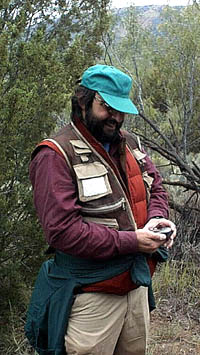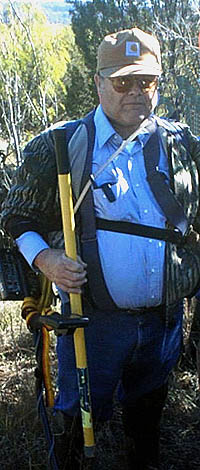This exhibit is truly the work of many, past and
present.
An initial, succinct draft of the exhibit was written
by Jeff Indeck and Rolla Shaller,
the curator and assistant curator of archeology, respectively,
at the Panhandle-Plains Historical Museum (PPHM). As the exhibit
plans grew, TBH editor Steve Black expanded the
text and incorporated many comments thoughtfully made by Chris
Lintz. Lintz is credited as one of the exhibit authors
because of both his extensive draft comments and the fact that his
dissertation and Stamper site articles were drawn upon repeatedly.
Historical insights were also borrowed from the other Plains Villager
exhibits written by David Hughes, Doug Boyd, and John Erickson.
Helpful outside (peer) review comments were made by Scott Brosowske
and Pat Mercado-Allinger.
Even more individuals helped provide the images. Rolla
Shaller and Chris Lintz deserve top billing. Time and time again,
Shaller scanned images from his own photograph collection and from
the archives of the Panhandle-Plains Historical Museum. Special
thanks are also due to archivist Betty Bustos and Jeff Indeck at
the PPHM for archival access, scans, photographs, and information.
Lintz gave Black access to his own slide collection and provided
leads on sources for many other images. Other photographers and
sources are credited in the image captions.
Links
http://www.tshaonline.org/handbook/online/index.html
Search the Handbook of Texas Online for the following topics:
Antelope Creek Phase, Buried City, Floyd V. Studer, Panhandle-Plains
Historical Society, and Panhandle-Plains Historical Museum.
http://www.ou.edu/cas/archsur/okpast.htm
Oklahoma's Past, part of the website of the Oklahoma Archeological
Survey that presents useful summaries of several excavated Plains
Village sites in Oklahoma via a clickable state map. In particular,
check out the entries for Texas County (Two Sisters site), Beaver
County (Roy Smith site), Cimmaron County (Kenton Caves), and Roger
Mills County (Zimms site), among others.
http://www.panhandlenation.com/explore/antelope_2.htm
Antelope Creek Ruins, Chronology of Exploration. This page
provides some useful historical information and quotations, but
it is not a complete and comprehensive chronology.
http://www.dempseydivide.org
Prehistory and Past Environments of the Dempsey Divide.
This website focuses on an area of western Oklahoma that has seen
intensive research led by landowner and archeologist Pete Thurmond.
The "Published Articles" section contains PDF versions
of various journal articles related to the Plains Villagers of Oklahoma
and the Texas Panhandle.
Print Sources
[See also the "Credit and Sources" sections
of the other Plains Villagers exhibits.]
Baker, Ele A. and Jewel A. Baker
2000 Archaeological Excavations of Antelope Creek Ruins and
Alibates Ruins, Panhandle Aspect: 1938-1941. Panhandle Archeological
Society, Publication 8. [Available from: Panhandle Archeological
Society, PO Box 814, Amarillo TX 79045]
Baerreis, David A., and Reid A. Bryson
1965 Historical Climatology and the Southern Plains: A Preliminary
Statement. Oklahoma Anthropological Society Bulletin 13:69-75.
1966 Dating the Panhandle Aspect Cultures. Oklahoma
Anthropological Society Bulletin 14:105-116.
Brooks, Robert L.
2004 From Stone Slab Architecture to Abandonment. In: Timothy K.
Perttula, ed., The Prehistory of Texas. Texas A&M University
Press, College Station.
Campbell, Robert G.
1976 The Panhandle Aspect of the Chaquaqua Plateau. University
Graduate Studies 11. Texas Tech University, Lubbock.
Couzzourt, Jim and Beverly A. Schmidt-Couzzourt
1996 The 1969 Texas Archeological Society Field School at Blue Creek,
Moore County, in the Texas Panhandle. Bulletin of the Texas
Archeological Society 67:1-113.
Duncan, Marjorie A.
2002 Adaptation During the Antelope Creek Phase: A Diet Breadth
and Site Catchment Analysis of the Subsistence Strategy at the Two
Sisters Site. Unpublished Ph.D. dissertation, Department of
Anthropology, University of Oklahoma.
Duffield, Lathel F.
1964 Three Panhandle Aspect Sites at Sanford Reservoir,
Hutchinson County, Texas. Bulletin of the Texas Archeological
Society 35:19-81.
1970 Some Panhandle Aspect Sites: Their Vertebrates
and Paleoecology. Unpublished Ph.D. dissertation, University
of Wisconsin. University Microfilms, Ann Arbor.
Etchieson, G. Meeks, and James E. Couzzourt
1987 Shoreline Survey at Lake Meredith Recreation Area in the
Texas Panhandle. U.S. Department of the Interior, Bureau of
Reclamation, Southwest Region, Amarillo.
Green, F. Earl
1986 Report on Archaeological Salvage in the Sanford Reservoir
Area. Panhandle Archeological Society, Publication 4. [Available
from: Panhandle Archeological Society, PO Box 814, Amarillo TX 79045]
Hobbs, Hulda
1941 Two Texas Panhandle Ruins. El Palacio 48(6):121-129.
Holden, W. C.
1929 Some Recent Explorations and Excavations in Northwest Texas.
Bulletin of the Texas Archeological and Paleontological Society
1:23-35.
Johnston, C. Stuart
1939 A Report on the Antelope Creek Ruin. Bulletin of the Texas
Archeological and Paleontological Society 11:190-202.
Krieger, Alex D.
1946 Cultural Complexes and Chronology of Northern Texas.
University of Texas, Austin. [Download
select sections in PDF format.]
LeBlanc, Steven A.
1999 Prehistoric Warfare in the American Southwest. University
of Utah Press, Salt Lake City.
Lintz, Christopher R.
1978 Architecture and Radiocarbon Dating of the Antelope Creek Focus:
A Test of Campbell's Model. Plains Anthropologist 23(82,
Part I):319-328.
1986 Architecture and Community Variability within
the Antelope Creek Phase of the Texas Panhandle. Studies in
Oklahoma's Past No. 14. Oklahoma Archeological Survey, Norman.
1989 The Upper Canark Regional Variant: Comparison
and Contrast of the Antelope Creek and Apishapa Phases of the Southwestern
Plains. In: Roper, Beryl C., ed, In the Light of Past Experience:
Papers in honor of Jack T. Hughes. Panhandle Archeological
Society, Publication 5. [Available from: Panhandle Archeological
Society, PO Box 814, Amarillo TX 79045]
2001 Architecture and Chronology at Landergin Mesa,
41OL2, Oldham County, Texas. La Tierra 28(2):10-39
2003-2004 "The Stamper Site, 34TX1, Texas County,
Oklahoma," four part series that appears in Oklahoma Archeology:
Journal of the Oklahoma Anthropological Society , beginning
with Part 1 in Volume 51(2):13-36.
Moorehead, Warren K.
1931 Archaeology of the Arkansas River Valley. Published
for the Department of Archaeology, Phillips Academy, Andover, Mass.,
by the Yale University Press.
Schmidt-Couzzourt, Beverly A.
1983 The Chicken Creek Site: Archeological Testing in the Lake
Meredith Recreation Area, Potter County, Texas. U.S. Department
of the Interior, Bureau of Reclamation, Southwest Region, Amarillo.
Studer, Floyd V.
1931 Archeological Survey of the North Panhandle of Texas. Bulletin
of the Texas Archeological and Paleontological Society 3:73-75.
1934 Texas Panhandle Culture Ruin No. 55. Bulletin
of the Texas Archeological and Paleontological Society 6:80-96.
1955 Archeology of the Texas Panhandle. Panhandle-Plains
Historical Review 28:87-95.
Watson, Virginia
1950 The Optima Focus of the Panhandle Aspect: Description and Analysis.
Bulletin of the Texas Archeological and Paleontological Society
21:7-68.
|


